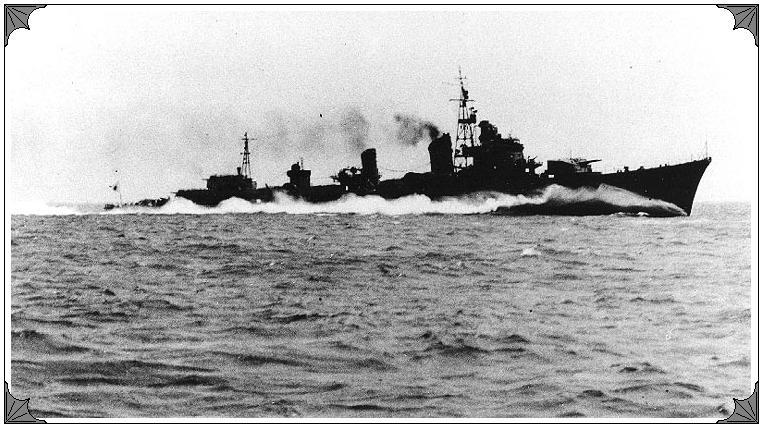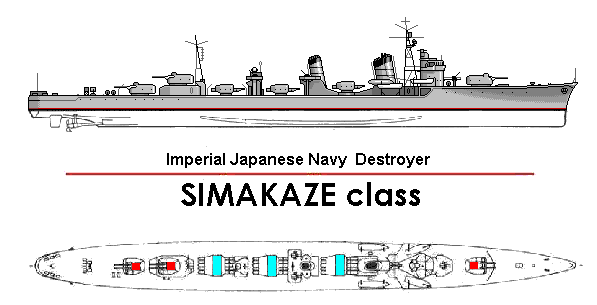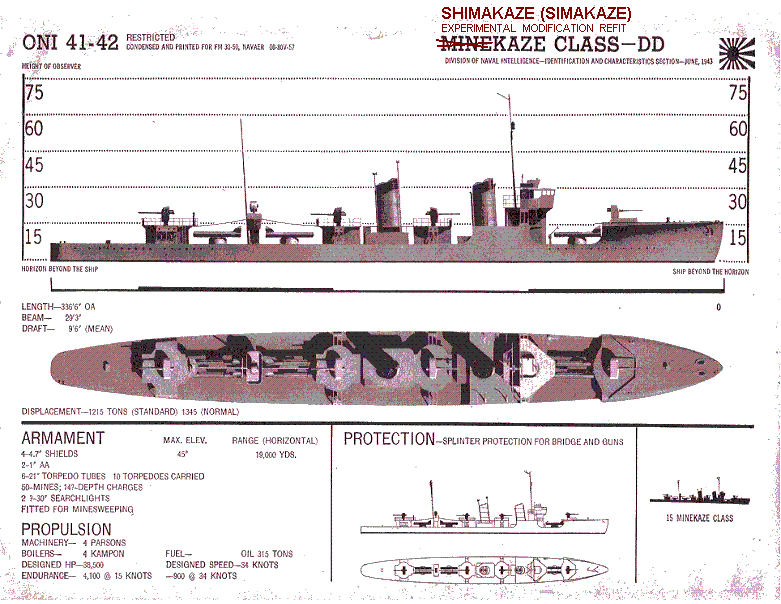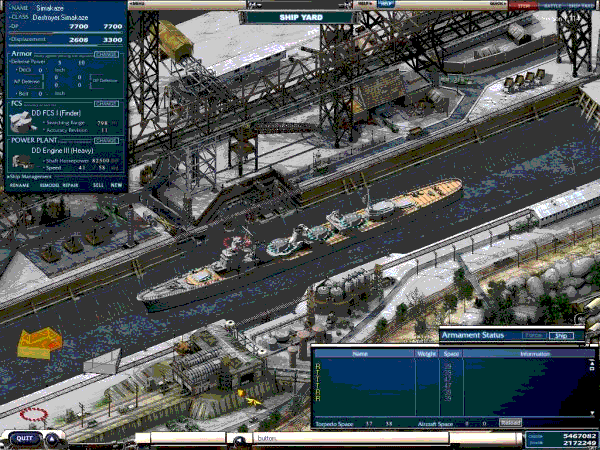
Imperial Japanese Navy - SIMAKAZE class Destroyer ==========================================================================

Shimakaze ("island breeze"), a 3048-ton destroyer, was built at Maizuru Naval Yard, Japan. Completed in May 1943, she was extraordinarily large and fast, with a very heavy torpedo armament. She was ordered in the 1939 Program as the prototype of a new heavy destroyer. She was the fastest destroyer built by Japan throughout the war with an advanced power plant producing fifty percent more power than her contemparies like the Yugumo and Asashio. However, despite the planned production of sixteen ships of her class, no more were built. Shimakaze was sunk by U.S. Navy carrier-based aircraft in the Philippines area on 11 November 1944.
The Minekaze and Momi class destroyers were essentially the evolution of a single design with each group representing progressive development. As such, they are historically important as a pivotal design between early foreign built ships and the later original and highly innovative Kagero / Fubuki "Special Type" destroyers and their successors (such as Simakaze) which played such a dominant role in the early surface battles of the Pacific War.
Prior to the First World War the Imperial Japanese Navy was very dependent on foreign suppliers for its arms and equipment. Many of the prominent overseas warship builders supplied vessels to the Imperial Navy with the majority being built in British yards. In addition, the Japanese Navy acquired many ships as prizes in both the war with China and the Russo-Japanese War. This combination allowed a very rapid expansion of the fleet while also affording ample opportunities to study foreign construction methods and techniques. Destroyers were purchased mainly from Yarrows and Thonnycroft, leaders in destroyer design at the time. Later, some units were built in Japan through licensing agreements.
As Japanese shipbuilding capacity expanded and the ship constructors gained more experience, original designs were built. Initially these were still based on British practice. The break from British design dominance occurred in 1916 when the Navy issued specifications for new First and Second Class destroyers. These new vessels, the Minekaze and Momi classes, departed from the traditional British layout, adopting a design that owed much to German ideas.
Shimakaze was entirely of Japanese design, but borrowed heavily from the concepts of the earlier German based Minekaze destroyers. The design of the Minekaze class destroyers was based off of German destroyer practices, as opposed to the British designs which had previously been the norm. Ranked as first class destroyers, the Minekaze class had an extended forecastle which was seperated by a well from the bridge to allow space for torpedo tubes in between, as well as decrease the affects of heavy seas. The elevation of the guns differentiated the Minekaze type from the other destroyers in the fleet at the time, as they were placed higher than the main deck along her entire length.
When compared with previous designs, the Minekaze class forecastle was lengthened with a break forward of the bridge forming a well deck where the forward torpedo mounts were placed. This well deck layout followed typical German torpedo boat design practice. A traditional turtledeck style forecastle was retained but the bow was flared more for better seakeeping qualities. All the main armament, guns and torpedoes, were mounted on the centerline so that all could bear on either broadside. Six 21" torpedo tubes in three twin mountings were provided. While not all of these new ideas were completely successful, (the forward gun and torpedo mounting were swept by water in heavy seas and were sometimes unworkable), generally the new destroyers were fast and powerful ships that were equal to any of their foreign contemporaries.
Essentially these vessels, in their external revision, set the pattern for the following Kamikaze class. Gun and torpedo positions were changed, the gun mounted aft of the second funnel was moved further aft to X position. Torpedo mounts 2 and 3 were moved closer together and the searchlight platform formerly between them was moved forward to just aft of the second funnel. The following Kamikaze class ships were visually identical apart from slight detail changes in the bridge/
The Minekaze, Kamikaze and Mutsuki class ships formed the backbone of Japanese destroyer formations throughout the twenties and thirties until they were supplemented and later replaced by the "Special Types". As the Fubuki class and their improved successors became available in numbers the Minekaze and Kamikaze ships were withdrawn from first line service and reassigned to secondary duties. The Mutsuki's were retained as first line destroyers due to their increased range and their more powerful torpedo armament.
The Mutsuki's, with their 24" torpedo mounts were able to accept the newly designed 24" oxygen driven "Long Lance" torpedo, a superb weapon with no equal in allied arsenals. With the new protected weather proof shields the torpedoes could be worked in all seas and weather conditions thus extending the useful life of the class in the fleet destroyer role. No such refit was contemplated for the Minekaze and Kamikaze classes as they were considered to be obsolete.
On paper, the additional anti-aircraft guns look impressive in their numbers but due to the fact that no central fire control system was developed to direct their fire the adding of more barrels firing independently had little effect on the ship's defensive capability. This serious deficiency in anti-aircraft defensive capability became more critical as the war progressed.
Shimakaze (Simakaze) was a one-off super-destroyer built for the Imperial Japanese Navy during World War II. A virtual cruiser, she was armed with six 127 mm dual purpose guns and conventional anti-aircraft and anti-submarine weaponry. More importantly, she was also armed with 15 torpedo tubes each capable of firing the deadly 24-inch Long Lance torpedo. The ship was a testbed for an enormously powerful high-temperature, high-pressure steam engine that was able to develop nearly 80,000 shaft horsepower. This made her one of the fastest destroyers in the world: her designed speed was 39 knots, but on trials she made 40.9 knots.
Shimakaze was planned and built as the experimental prototype of a new class of heavy fleet destroyer, designated "Type C." Sixteen other units were ordered but later cancelled due to more pressing wartime needs. Though never repeated, Shimakaze was a successful design, combining large size (some 25 feet longer than YUGUMO), firepower (six 5" guns in new Type D turrets), and heavy torpedo armament (three quintuple sets of 24" tubes, the most powerful such broadside ever mounted on a Japanese destroyer) with a 40-knot top speed. The latter was thanks to new high-pressure, high-temperature boilers which developed nearly 80,000 shaft horsepower and would have propelled all future Japanese destroyer designs, had circumstances permitted their construction.
All experimental projects were set aside at the beginning of the war in favor of more urgent work, so Shimakaze, though laid down in July of 1941, was not completed until the spring of 1943. The delays in her construction did, however, enable her to be fitted with the very latest equipment, and Shimakaze was one of the first Imperial warships to mount radar when completed.
One word sums up this magnificent vessel: power. She had a top speed of almost 40 knots (that's really moving, people), 6 x 5" guns, and a main torpedo battery of 15 (count 'em) 24" tubes. She was, in my opinion, the most powerful destroyer of the war -- the superb U.S. Allen Sumner had comparable gun power and better fire control, and the French Mogadors had the same speed and superior 8 x 5.5" gunpower (not to mention almost 1,000 tons of full load displacement -- nearly a light cruiser), but neither of these classes had the kind of torpedo battery capable of scuppering an entire squadron of opponents at a crack. Of course, because of her outsized powerplant she was far too expensive to be built in any sort of quantity (Japan was losing the war big-time by the time she was launched), and her sixteen sister ships were never laid down. What a pity.
As none of her contemporaries could match her performance characteristics, Shimakaze was never assigned to any individual destroyer division, but operated more or less independently within the squadron structure. If Shimakaze's service as radar guide and screen flagship for the Kiska evacuation was the high point of her career, then her "non- participation" in the Battle off Samar (held back due to her being encumbered by MAYA survivors) was probably the low: her mighty torpedo batteries would never have had better targets. Her crew fought hard and died bravely with her under overwhelming air assault in Ormoc Bay. But overall, Shimakaze seems to have enjoyed a very "ordinary" career for a warship of such extraordinary potential.
=================================================================================
NB: The above text has been collected / excerpted / edited / mangled / tangled / re-compiled / etc ... from the following online sources :
IJN - SIMAKAZE class Destroyer - wikipedia article
IJN - SIMAKAZE class Destroyer - www.combinedfleet.com article #1
IJN - SIMAKAZE class Destroyer - www.combinedfleet.com article #2
IJN - SIMAKAZE class Destroyer - smmlonline.com
IJN - SIMAKAZE class Destroyer - www.globalsecurity.org article #1
IJN - MINEKAZE class Destroyer - www.globalsecurity.org article #2



